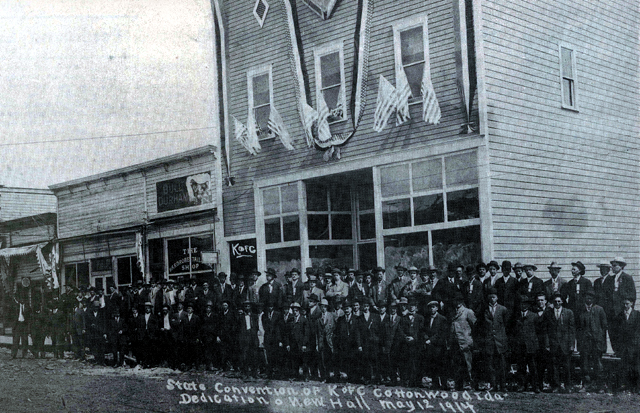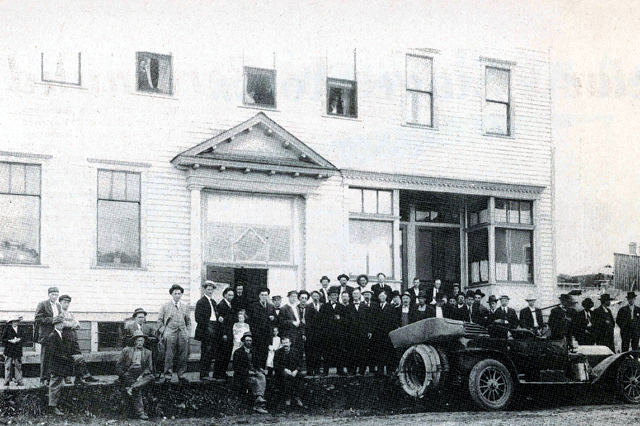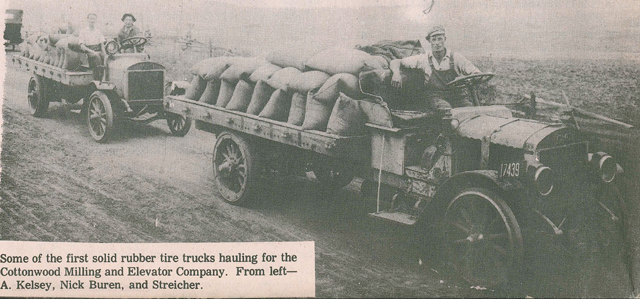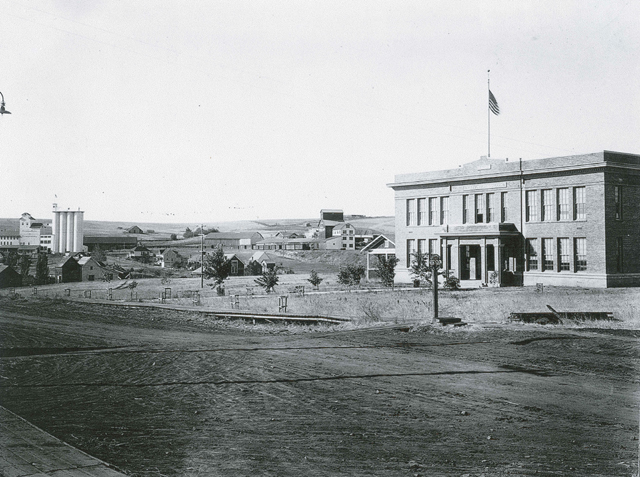| Cottonwood
to celebrate 150th year in 2012, area history included
(Cottonwood history continued from last week) Some of the area’s small (1 room) schools were set up and operated as early as 1895 and ran until 1959 before being incorporated into the larger village schools. Keuterville was first in the area to draw the settlers, evidently because of the ready supply of timber for firewood and building. People knew from others who started new settlements that to draw others to the area they must tend to the basic needs of the people. Two of the most demanding needs were 1) basic education and 2) the building of a bridge between man and his maker, religion. Thus attention was immediately drawn to building schools and places of worship. While each of these demands must be met, it was the people themselves who would decide when and where these buildings would be erected. About 1895 the small 1-room school started to pop up in various locations where 8 or 10 would-be scholars lived or could reach by walking or riding during the school season. The Timber School, the Deep Creek School, the Moughmer Pt. School or Buettner School, and the Keuterville School came into being. Also about this time the first Catholic Mass was held in the area in one of the local homes. The first church was built shortly thereafter and burned down to be replaced by the church that still stands today. The church when dedicated was named “Holy Cross Church.” Prior to 1906 or 1907 the location of the coming railroad was up for speculation. There were 8 to 10 businesses already built in Keuterville and a few more on the drawing board. Population there was about 100 to 150. Because of the stage route, population in Cottonwood was about 600 at this time. When the train came in 1908 this jumped to about 900 people. Many of the stores in Keuterville closed and the people moved out on the prairie during the next 10 years. The school term varied from 3 to 7 months to begin with. This was set by accessibility and the weather as the children were needed at home to help with the chores. --Meanwhile in Cottonwood— City Council 1903: E.S. Hancock was advised to discontinue the use of stovepipe in photo studio. (build adjacent chimney instead). City Council 1904: The marshal was to stop children from sleigh-riding on village sidewalks. Ordinance #27 (1905): Unlawful to keep open any business on Sunday except drug stores, livery stables, hotels or boarding houses and restaurants. Ordinance #32 (1906): Sec. 1-No Bawdy House, house of ill fame or disorderly house shall be kept and maintained within the limits of the Village of Cottonwood. Slowly but surely Cottonwood built back after the hailstorm, fire and other “new town” problems. One of the big projects was the new K of C Hall built on the north side of Main Street across from the Cottonwood House and Hotel. The State Convention was held in the new hall on May 12, 1914. The German State Bank was rebuilt and continued to operate. Later, about 1917 when the U.S. entered World War 1, this was changed to the Cottonwood State Bank. In Greencreek the church, the school and first Greencreek Store and Shop were built and became the local focus of a growing community. In Ferdinand the coming of the railroad settled the dispute over the location of the business district. The church and school were up and running. Ferdinand also had a repair (blacksmith) shop and general merchandise store. Milk sold for 5¢ a quart, 15¢ per gallon. A gold 15-jewel Elgin watch changed hands for $12. Lumber, finished grade, was about $17 per thousand with rough cut selling for $7. $400 would build a small 4-room house. $700 was “top of the line.” Cars and trucks (with hard rubber tires) started to show up along Main St. about 1914 or 1915. WWI was starting to draw some of the local young men away to a war in the old country. The present Hotel building was built out of bricks and if you notice there used to be a couple of wide doors at street level. This is because about this time it was a car repair shop before it became the “Royale” Café and Bar. This was a pretty place to live but like in other places the old-timers suffered from many ailments like flu, severe colds and chills and there were no antibiotics to be had so many people, both young and old, died of these afflictions. It seems there was some sort of epidemic about every 10 years where people were quarantined t their homes to help control the spreading sickness. Through it all the area continued to grow. Just like today, some have better skills than others. Some make it through hard times, others loser their homes and ranches and move on. Some make their own luck and others just succumb to it. Like people all over the world, about the time “things can’t get any worse” things did! Records show that about 140 men from this area served in some capacity during WWI. We showed great support for all the men serving and local patriots demanded the use the German language cease both in public and at home. Several young me from here were lost but not forgotten in this dirty war. Everyone displayed their flags and the town erected a new, extra tall (102’) flag pole. New meanings and feelings were proudly spoken and all the patriotic songs were sung at every gathering. Last, but not least, were the “going away’ and later the “coming home” parties which drew the area even more together. About the time the war was winding down and the last of the returning men were coming home, the town was in the middle of a flu epidemic and some of the celebrations were altered or cut short. In about November 1917 they ordered a quarantine for everyone to stay home. Of course this was not entirely possible. Go look in the local cemeteries. Many people died from the flu and related illnesses from 1917 through the late 1920’s. Old records show that hard times mixed with the flu really raised Cain with the families of the area in the early 1920’s. Many farms were lost and the paper was full of farm auctions and bad or unfavorable weather conditions. There were several cloudbursts and 5 mile wide hail storms and even a grasshopper plague! People banded together trying to help each other. About the time things would start to look better, some other thing would come along to test the people’s mettle. A strong will and even stronger determination finally prevailed and people started to see daylight in the coming 1930’s. One more time—any of you readers of this area who have not been contacted for your family history, please contact us as we realize that, through oversight, some of you might not have been asked for your stories. Please see Deb at U.S. Bank or give Don Hoene a call. Also if you have pictures we can share. The next meeting of the 150-year committee will be next Thursday, Nov. 10, at 2 p.m. at the Library. Anyone with interest in this project is welcome to attend. 
The State Convention for the Knights of Columbus was held in Cottonwood in 1914 with the new KC Hall being dedicated at that time. It stood on the north side of Main St. approx. where Forsmann Accounting now sets. Scanned from July 1, 1976 Chronicle. 
The old Cottonwood Hotel. A There was a Democratic Rally there in about 1916. Gov. Moses was in the center wearing a top hat and holding a cigar. The hotel stood where the old Texaco building is now which serves currently as a warehouse for Bud’s Saw Service. Scanned from July 1, 1976 Cottonwood Chronicle. 
Scanned from the July 1, 1976 Chronicle 
The former Cottonwood School not long after it was built as evidenced by the small trees in front that were planted about the time it was built. That’s Lewiston Street in the foreground. Photo provided by Don Hoene. Remember When Remember when… Your family got it’s first car? Old John Shoberl (sp?) came around to plow the family garden? Johnny Seubert’s family delivered milk before school? (Mainly the Twins and Bernard) Tony & Josephine Duclos ran the dairy in northwest Cottonwood? Tony Uhlenkott ran a rock crusher on King Street across from the Catholic Church? The first school in Greencreek sat on the north side of the road? The first store in Greencreek was built on the south side of the road? Hoffman’s? The Wassmuths took over the store and relocated to the north side of the road? The snow just plain shut down the roads? There were 3 grocery stores in Ferdinand? (Gilberts, Herzogs and Kuthers) Margie Hayden was the telephone operator? Hoene’s Inn? (Tony and Barbara) The “Twin Gables” was the hot spot. Ann and Martin Kroiss ran the Post Office? What a difference when the railroad came to town? Your first ride on the rail? The farewell party for the men who went to war? Also the welcome home party for the same? |
|